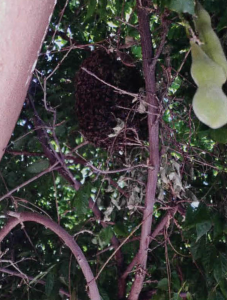By: TJ Carr
This article originally appeared in the Summer 2019 issue of BEEKeeping Your First Three Years
In late August I was called to collect a swarm from a residence in Dietz Farm, a sleepy and semi-rural area of the Rio Grande valley that runs through Albuquerque, New Mexico. It was early on a Saturday morning when I arrived. As I entered the courtyard of the home, I became aware of a plethora of bees occupying a mature wisteria growing over the gate. Two elderly sisters owned the home and informed me the swarm was in the wisteria, which had been growing over and around the gate for more than forty years. Visitors, the ladies explained, had to navigate past these bees; a situation that at times created much apprehension.
My initial inspection revealed a large swarm attached to one of the wisteria branches. I estimated the mass of bees to weigh at least ten pounds. My visibility of the swarm was limited greatly by the dense growth and I explained to the sisters that I was prepared to collect the swarm then and there, but the process would require me to trim away a relatively large section of the wisteria. The women balked at this element of the collection procedure and decided to leave the plant and bees as they were when I arrived.
A couple of days later one of the women called and told me she and her sister had changed their minds. She requested I return and collect the swarm, giving me the go-ahead to trim the wisteria as required to accomplish the task. I assured her that I shared her feelings about the plant and would remove only as much of the foliage as it took to access and remove the swarm.
I recruited Chase Bramer, a younger skilled beekeeper, to assist, and early the next morning we arrived at the residence to collect the swarm. We carefully trimmed only enough of the wisteria away to access the large clump of bees and, lo and behold, we discovered a mass of honeycomb beneath the large and living veneer of worker bees. My initial assessment of a ten pound swarm was corrected – I now estimated there were approximately five pounds of bees and five pounds of resources, i.e., honeycomb and honey.
It was a beautiful morning and a beautiful experience as we completed our trimming and cut the branch that hosted the colony. There were thousands upon thousands of bees in the still air, their collective humming and movements devoid of aggression as we transferred the swarm and its resources into a nuc. We placed the nuc on top of a waste bin near the gate and left an open topbar to afford access for the bees come eventide. The familiar smell of the queen would attract the fliers into the nuc, a process aided by the close proximity of the nuc to their previous home.
That evening, after nightfall, I retrieved the nuc and the next day transferred the resources to comb savers. Once the colony becomes settled in the nuc, it will be moved to a standard topbar hive as a permanent home.
Collecting this swarm, which was already beginning to mature into a permanent colony, was a great experience. The bees were easily one of the gentlest colonies I ever worked. The quiet North Valley setting, the wildness of the old wisteria, and the mild temperament of the bees – all of it combined to make the collection one of the most enjoyable I’ve experienced. The attached photos further document our morning at the sisters’ home. Note the abundance of pollen in the workers’ collection baskets.















